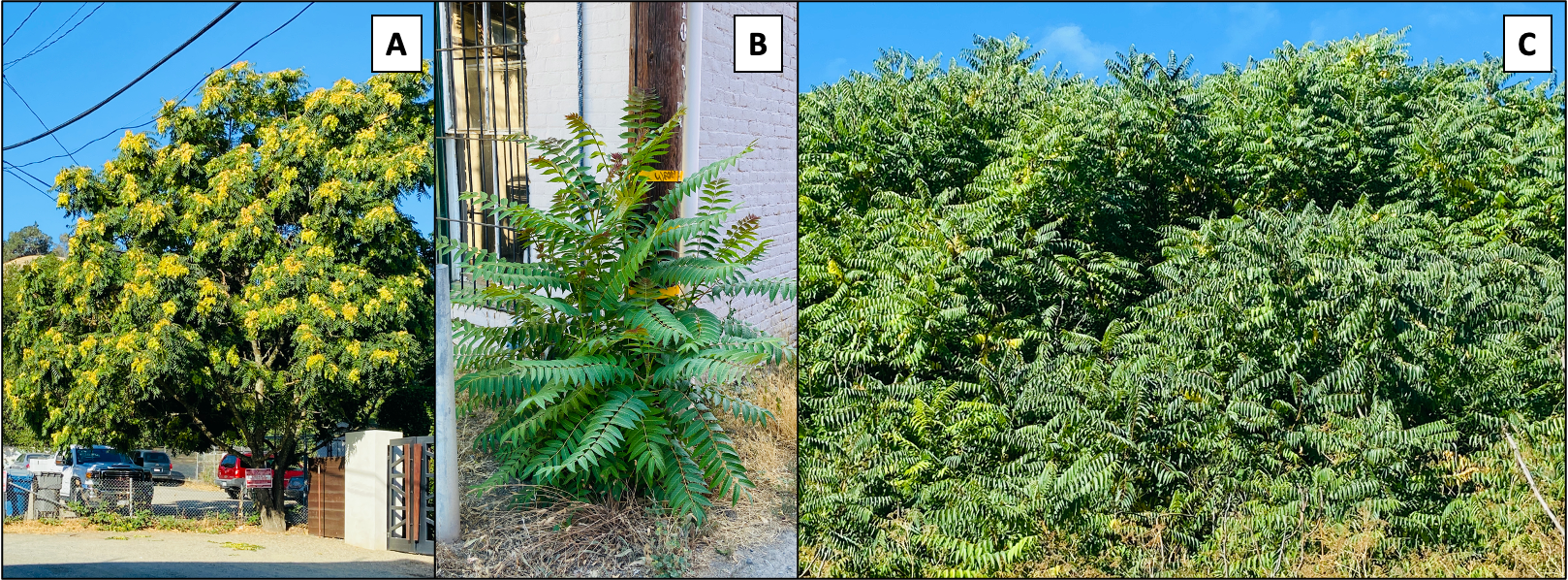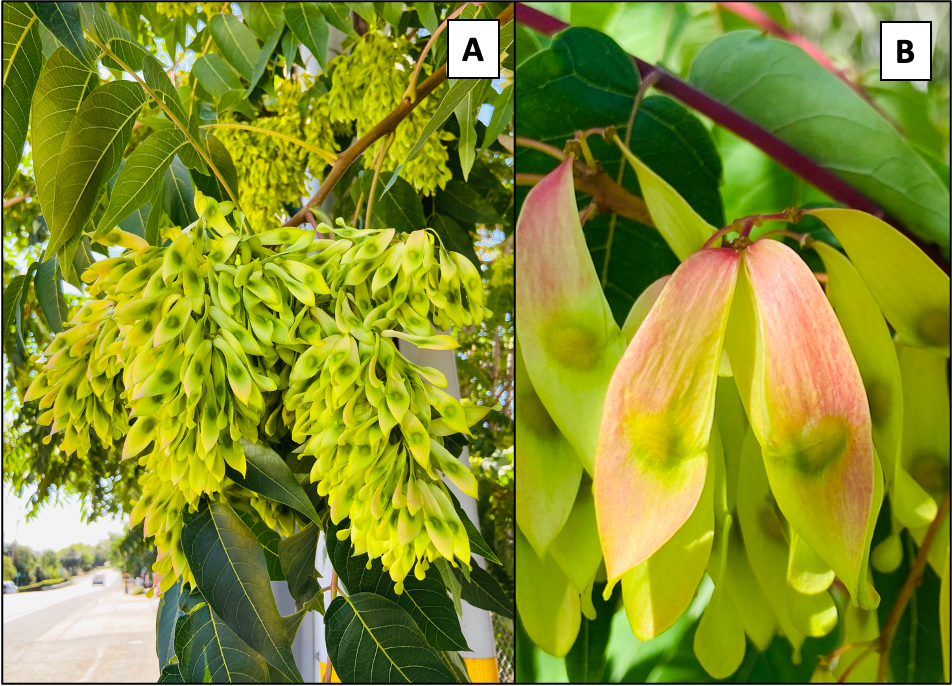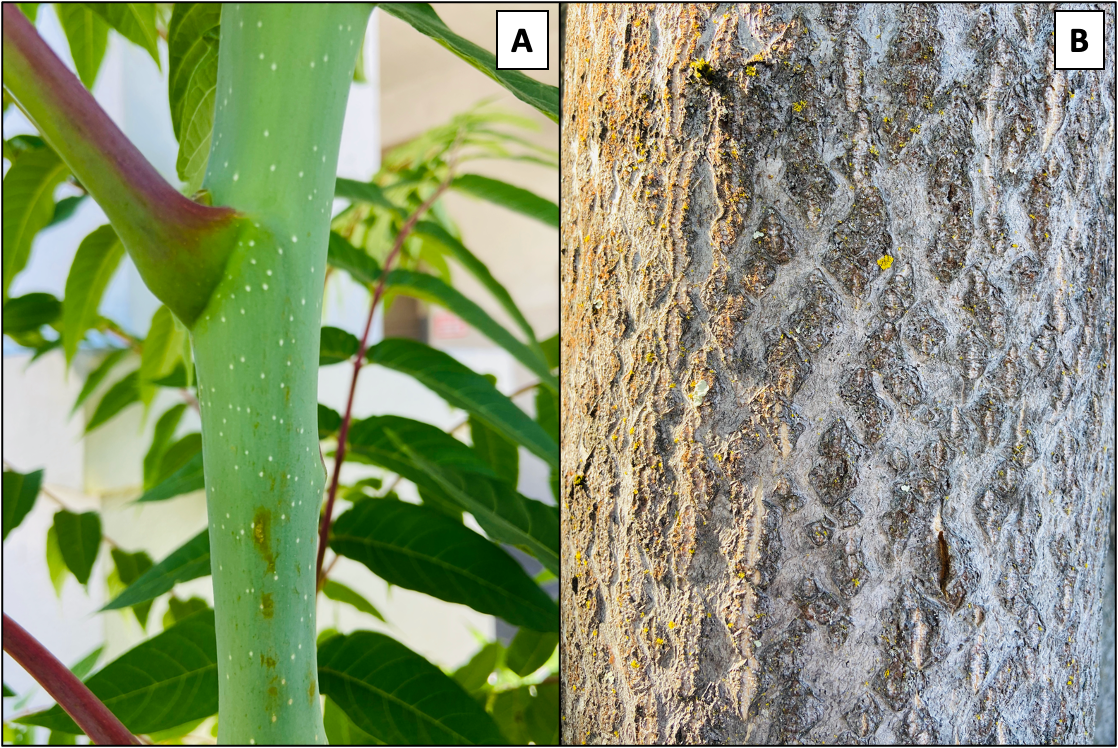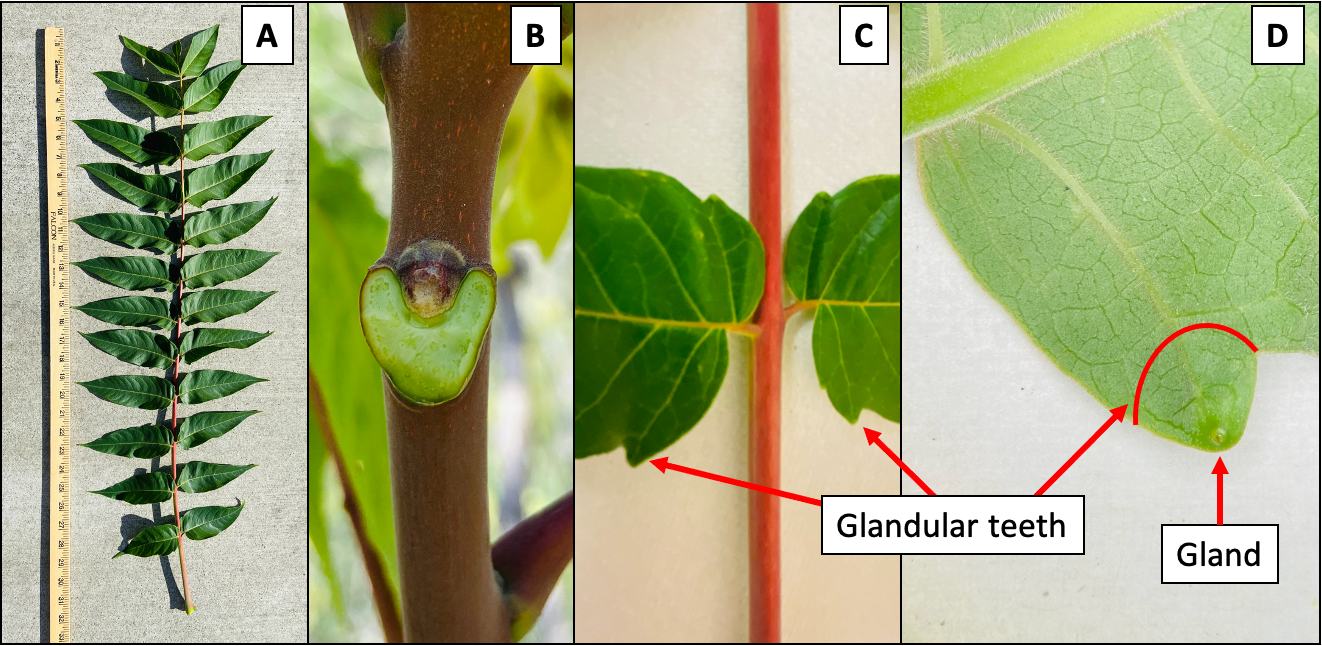Invasive tree-of-heaven is a preferred host for two invasive insect pests that cause economic damage in California agricultural crops
It is not uncommon for commercial agriculture to share a common boundary with riparian, forested or urban areas in California. Some pest species thrive in these border areas and serve as a source of insect pest pressure on neighboring commercial crops. Invasive species that find preferred hosts in these border areas can be especially problematic in that their new environment lacks the predators from their native habitat that would normally suppress and keep their population manageable. This uncontrolled population growth can result in significant economic damage to nearby commercial crops.
The tree-of-heaven (TOH), Ailanthus altissima, is an invasive tree that has been documented in 45 states including California. This deciduous tree can be found in agricultural, urban, riparian and disturbed forested areas (Fig. 1A, 1B). This tree serves as a preferred host of two invasive species: the brown marmorated stink bug (BMSB), Halyomorpha halys, and the spotted lanternfly (SLF), Lycorma delicatula.

Figure 1. Tree-of-heaven is a deciduous tree that can be found in agricultural, urban, riparian and disturbed forested areas. Credit: Cindy R. Kron, UC IPM.
In California, BMSB is established in 16 counties and detected in 23 additional counties. The brown marmorated stink bug has over 170 host species (fruit, nuts, vegetables, and ornamentals) including the following agricultural crops: grape, pear, apple, stone fruit, citrus, blueberry, raspberry, blackberry, fig, almond, hazelnut, sunflower, sweet corn, soybean, okra, bell pepper, green bean, tomato, and eggplant. To date, in California, BMSB has been observed causing damage in commercially grown almond, apple, peach, and pear orchards.
The SLF has been recorded in 6 East Coast states but has not yet been documented in California. This insect lays eggs on plant and nonplant items such as stones, pallets, outdoor furniture, railway cars, firewood, and vehicles, which contributes to their wide dispersal ability and their likelihood of unintentional introduction into California. The SLF has at least 40 host species (fruit, nuts, ornamentals, and woody trees) found in North America including the following agricultural crops: grape, stone fruits, apple, blueberry, fig, hops, walnut, and almond.
BMSB and SLF share some similarities. Both are native to China, introduced into the U.S. via Pennsylvania, cause economic damage in a range of commercial crops found in California, and aggregate in large numbers. The tree-of-heaven is a preferred host.
In addition to supporting the growth of economically damaging insect pests, the tree-of-heaven has its own impacts on the ecology of areas where they establish. The tree-of-heaven competes with native plants and trees by releasing allelopathic chemicals that prevent the establishment and inhibit the growth of native trees nearby (Fig. 1C). The tree has a rapid growth rate of 3 to 6 feet a year and is able to start bearing seeds within 2 to 3 years. Female trees can produce more than 300,000 seeds (Fig. 2A) that are easily dispersed by the wind allowing for new trees to establish some distance from the parent tree. Established trees can also spread by sending up root suckers up to 50 feet from the parent tree. In addition, small root fragments can also generate new shoots. An injured or cut tree-of-heaven responds by producing numerous root sprouts that allows the tree to spread prolifically and complicates efforts to remove the invasive tree. The tree-of-heaven is a high pollen producer aggravating those with allergies. Direct contact can cause skin irritation and, in rare cases, inflammation of the heart muscle has been documented from exposure to sap through broken skin. These features of tree-of-heaven fuels its ability to invade new environments and makes it very difficult to remove after it has become established.

Figure 2. Female trees can produce more than 300,000 red, yellow and green “samaras” that each contain one seed covered by a winged and papery tissue used in wind dispersal. Credit: Cindy R. Kron, UC IPM.
Being that the tree-of-heaven is invasive and also supports two invasive insect pests that are known to cause economic damage in a range of commercial agriculture crops grown in California, it is important for the agriculture industry to become familiar with how to identify the tree-of-heaven. This knowledge can be used to increase the awareness of the proximity of these trees to host crops that you work with, manage or own. Calculated management decisions can then be made from this information.
The tree-of-heaven is similar in appearance and can easily be confused with a handful of native tree species: black walnut (Juglans nigra), winged/shining sumac (Rhus copallina), ash (Fraxinus spp.), staghorn sumac (Rhus typhina) and butternut walnut (Juglans cinerea). Young tree-of-heaven have greenish smooth bark (Fig. 3A) that turns a greyish-brown in older trees resembling the skin of a cantaloupe (Fig. 3B). Leaves have a central stem with 10 to 40 leaflets attached on each side by a short petiole (Fig. 4A). A V-shaped or heart-shaped scar is noticeable when a leaf is broken off of the main stem (Fig. 4B). The margins of the leaflets are smooth with one to two bumps called glandular teeth that protrude at the base of each leaflet near the petiole (Fig. 4C). A corresponding gland is located on the underside of the leaflet where the glandular teeth are located (Fig. 4D). A strong odor described as cat urine, rancid cashews or burnt peanut butter is given off when the leaves or stems are crushed. Twigs break easily exposing a brown spongy pith. Tree-of-heaven are dioecious with separate male and female trees. Female trees produce red, yellow and green “samaras” that each contain one seed covered by a winged and papery tissue used in wind dispersal (Fig. 2B).

Figure 3. Young tree-of-heaven have greenish smooth bark (A) that turns a greyish-brown in older trees resembling the skin of a cantaloupe (B). Credit: Cindy R. Kron, UC IPM.

Figure 4. Leaves have a central stem with 10 to 40 leaflets attached on each side by a short petiole (A). Leaves broken off of the main stem leave a V- or heart-shaped scar (B). The margins of the leaflets are smooth with one to two glandular teeth that protrude at the base (C). A gland is located on the underside of the leaflet where the glandular teeth are located (D). Credit: Cindy R. Kron, UC IPM.
Agricultural land and nearby areas should be inspected for existing tree-of-heaven stands. There are different strategies that can be followed upon identifying this tree in or near farmed land. The first strategy is to use the tree-of-heaven as a sentinel tree that is visually inspected periodically for the presence of BMSB and SLF life stages during the growing season. This would be an easy and ideal option if either invasive pest is not reported in your county or nearby counties. Early detection can help prevent establishment in your county and the economic damage that these invasive species cause in commercial crops. Any sightings or insect samples should be submitted to your local county agricultural commissioner's office.
A second strategy could be used if detections of either invasive species have occurred in your county or local area. Traps for BMSB monitoring can be deployed using a double-sided sticky panel with a dual lure and placed near the tree-of-heaven. If SLF were to arrive in California, brown sticky bands wrapped around the trunks of tree-of-heaven can capture the immature stages as they engage in their typical behavior of walking up the tree. Trap finds can alert growers of an invasive species presence in an agricultural field and treatment decisions can then be made.
A third strategy would be to remove tree-of-heaven, but this comes with a warning: mowing or cutting, by themselves, are ineffective and can cause the tree to spread prolifically. Care needs to be taken when deciding to remove tree-of-heaven since a cut tree responds by sending up numerous root sprouts up to 50 feet from the parent tree. Timing of treatment and commitment to follow up with subsequent treatments the following year are crucial for success. If tree removal is the decision made, the root system should be targeted with a systemic herbicide 30 days before cutting the trees and the application needs to be made between July and mid-October when carbohydrates are being allocated to the root system. If an herbicide is applied outside of this range, the application would likely be ineffective due to targeting the above ground growth and not the root system. Gloves, long-sleeved shirts and pants should be worn during tree removal to prevent the contact of tree parts and sap with the skin. Follow-up monitoring is needed to determine the need and timing of additional treatment applications.

